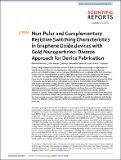Files in this item
Non-polar and complementary resistive switching characteristics in graphene oxide devices with gold nanoparticles : diverse approach for device fabrication
Item metadata
| dc.contributor.author | Khurana, Geetika | |
| dc.contributor.author | Kumar, Nitu | |
| dc.contributor.author | Chhowalla, Manish | |
| dc.contributor.author | Scott, James F. | |
| dc.contributor.author | Katiyar, Ram S. | |
| dc.date.accessioned | 2019-10-28T12:30:08Z | |
| dc.date.available | 2019-10-28T12:30:08Z | |
| dc.date.issued | 2019-10-22 | |
| dc.identifier | 262431816 | |
| dc.identifier | f3676c34-56f5-486e-a61f-1b84533dd9ee | |
| dc.identifier | 85073750948 | |
| dc.identifier | 000491306300003 | |
| dc.identifier.citation | Khurana , G , Kumar , N , Chhowalla , M , Scott , J F & Katiyar , R S 2019 , ' Non-polar and complementary resistive switching characteristics in graphene oxide devices with gold nanoparticles : diverse approach for device fabrication ' , Scientific Reports , vol. 9 , 15103 . https://doi.org/10.1038/s41598-019-51538-6 | en |
| dc.identifier.issn | 2045-2322 | |
| dc.identifier.other | RIS: urn:B21E76D66606058D88A9B453F23A3EE9 | |
| dc.identifier.other | RIS: Khurana2019 | |
| dc.identifier.uri | https://hdl.handle.net/10023/18788 | |
| dc.description | The author (G. Khurana) acknowledge the financial support from DOD Grant (AFOSR‐FA9550-16-1-0295). | en |
| dc.description.abstract | Downscaling limitations and limited write/erase cycles in conventional charge-storage based non-volatile memories stimulate the development of emerging memory devices having enhanced performance. Resistive random-access memory (RRAM) devices are recognized as the next-generation memory devices for employment in artificial intelligence and neuromorphic computing, due to their smallest cell size, high write/erase speed and endurance. Unipolar and bipolar resistive switching characteristics in graphene oxide (GO) have been extensively studied in recent years, whereas the study of non-polar and complementary switching is scarce. Here we fabricated GO-based RRAM devices with gold nanoparticles (Au Nps). Diverse types of switching behavior are observed by changing the processing methods and device geometry. Tri-layer GO-based devices illustrated non-polar resistive switching, which is a combination of unipolar and bipolar switching. Five-layer GO-based devices depicted complementary resistive switching having the lowest current values ~12 µA; and this structure is capable of resolving the sneak path issue. Both devices show good retention and endurance performance. Au Nps in tri-layer devices assisted the conducting path, whereas in five-layer devices, Au Nps layer worked as common electrodes between co-joined cells. These GO-based devices with Au Nps comprising different configuration are vital for practical applications of emerging non-volatile resistive memories. | |
| dc.format.extent | 10 | |
| dc.format.extent | 2327010 | |
| dc.language.iso | eng | |
| dc.relation.ispartof | Scientific Reports | en |
| dc.subject | QC Physics | en |
| dc.subject | NDAS | en |
| dc.subject.lcc | QC | en |
| dc.title | Non-polar and complementary resistive switching characteristics in graphene oxide devices with gold nanoparticles : diverse approach for device fabrication | en |
| dc.type | Journal article | en |
| dc.contributor.institution | University of St Andrews. School of Physics and Astronomy | en |
| dc.contributor.institution | University of St Andrews. School of Chemistry | en |
| dc.contributor.institution | University of St Andrews. Condensed Matter Physics | en |
| dc.identifier.doi | 10.1038/s41598-019-51538-6 | |
| dc.description.status | Peer reviewed | en |
This item appears in the following Collection(s)
Items in the St Andrews Research Repository are protected by copyright, with all rights reserved, unless otherwise indicated.

